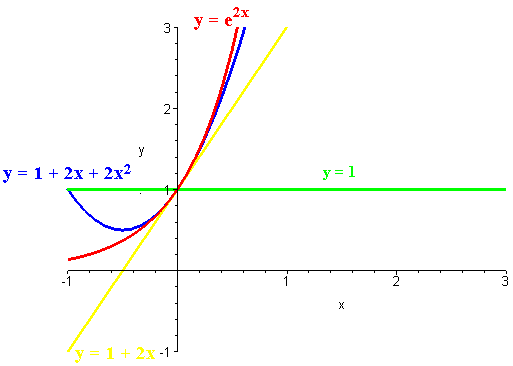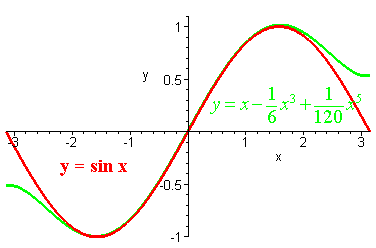Taylor Polynomials
Review of the Tangent Line
Recall that if f(x) is a function, then f
'(a) is the slope of the tangent
line at x = a. Hence
y - f(a) = f '(a) (x - a)
or
P1(x) = y
= f(a) + f '(a) (x - a)
is the equation of the tangent
line. We can say that this is the best linear approximation to
f(x) near a.
Note:
P1'(a) = f '(a).
Quadratic Approximations
Example
Let
f(x) = e2x
Find the best quadratic approximation at x =
0.
Solution
Note
f '(x) = 2e2x
and
f ''(x) = 4e2x
Let
P2(x) = a0 + a1x +
a2x2
Take derivatives we obtain
P'2(x) = a1 + 2a2x
and
P''2(x) = 2a2
We want the derivatives of f and P
to match up. We have
P2(0) = a0
= f(0) = 1
Hence
a0 = 1
Next
P2'(0)
= a1 = f '(0) = 2
Hence
a1 =
2
Finally
P2''(0) = 2a2 =
f ''(0) = 4
Hence
a2
= 2
So
P2(x) = 1 + 2x + 2x2

Notice that the tangent line approximates the curve well for values near x
= 0, however the quadratic approximation is a better fit near this
point. This leads us to the idea of using higher degree polynomials to get
even better fitting curves.
The Taylor Polynomial
Suppose that we want the best nth degree approximation to f(x)
at x = a. We compare f(x) to
Pn(x) = a0 + a1(x - a) +
a2(x - a)2 + a3(x - a)3
+ ... + an(x - a)n
We make the following observations:
f(a) = Pn(a)
= a0
so that
a0
= f(a)
Now we investigate the first derivative.
f '(a) = P'n(a)
= a1 + 2a2(x - a) +
3a3(x - a)2 + ... + nan(x - a)n-1
at x = a
so that
a1 = f '(a)
Taking second derivatives gives
f ''(a) = P''n(a) = 2a2
+
(3)(2)a3(x - a)+ ... + n(n - 1)an(x - a)n-2
at x = a
so that
1
a2 =
f ''(a)
2
Note Each time we take a derivative we pick up the next integer in other
words
1
a3 =
f '''(a)
(2)(3)
If we define f(k)(a) to mean the kth derivative of
f evaluated at a then
1
ak =
f (k) (a)
k!
We now have the key ingredient for our main result.
|
The Taylor Polynomial The nth degree Taylor polynomial at x = a is
f
''(a)
f (3)(a)
f (n)(a)
|
The special case when a = 0 is called the McLaurin
Series
|
The McLaurin Polynomial The McLaurin Polynomial of a differentiable function f(x) is 
|
Examples:
Find the fifth degree McLaurin Polynomial for sin x.
Solution
We construct the following table to assist in finding the derivatives.
| k | f (k)(x) | f (k)(0) |
| 0 | sin x | 0 |
| 1 | cos x | 1 |
| 2 | -sin x | 0 |
| 3 | -cos x | -1 |
| 4 | sin x | 0 |
| 5 | cos x | 1 |
Now put this into the formula to get
1
0
-1
0
1
P5(x) = 0 +
x +
x2 +
x3 +
x4 +
x5
1!
2!
3!
4!
5!
x3 x5
= x -
+
6 120
Notice how well the McLaurin polynomial (in green)
approximates y = sin x (in red) for on period.

Taylor's Remainder
Taylor's Remainder Theorem says that any smooth function can be written
as an nth degree Taylor polynomial plus a function that is of
order n + 1 near x = c.
Taylor's Remainder
Theorem
f (n+1)(z)
|
Example
We have
(0.1)3 (0.1)5
sin z
sin(0.1) = 0.1 - +
-
(0.1)6 = .099833416667 + E
6
120 6!
Where
1
E <
(.1)6 = .0000000014
6!
We see that the error quite small.
Back to the Math 107 Home Page
Back to the Math Department Home Page
e-mail Questions and Suggestions
